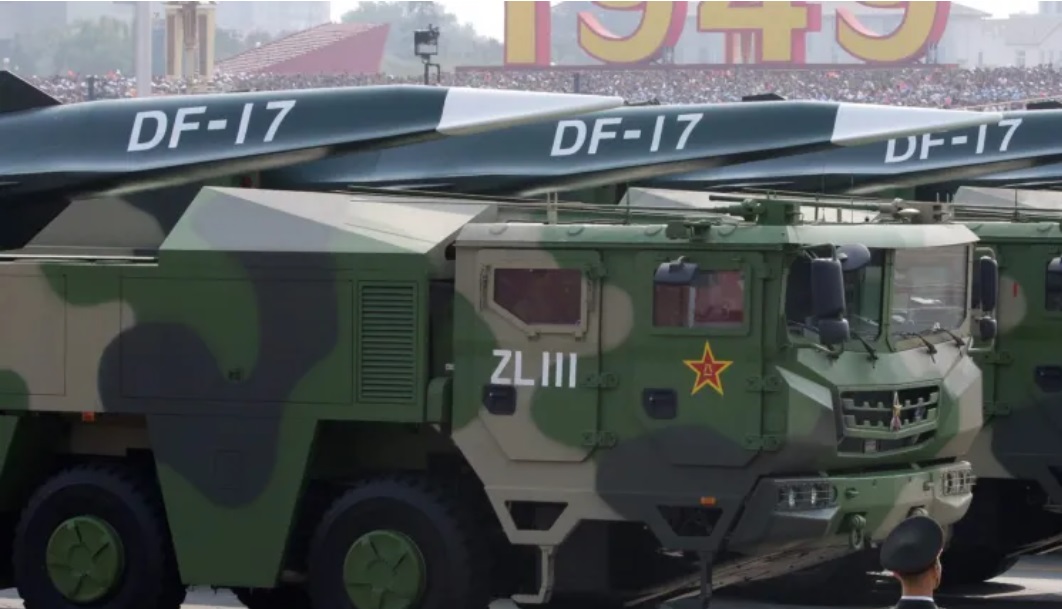In a development that could fundamentally change the strategic dynamics of South Asia, reports indicate that Pakistan is in the initial stages of negotiations with China to obtain advanced hypersonic missile technology, particularly the DF-17 system equipped with the DF-ZF Hypersonic Glide Vehicle (HGV).
Indian defense sources assert that Islamabad’s quest for this cutting-edge capability is motivated by the necessity to counter India’s increasingly robust multi-layered missile defense network.
The acquisition of hypersonic glide vehicle technology—capable of bypassing even the most advanced missile defense systems—could provide Pakistan with a significant advantage in both strategic deterrence and rapid precision strike capabilities.
It is believed that Pakistan is considering two possible paths: a direct transfer of China’s DF-ZF HGV technology or a collaborative development agreement based on the existing intelligence-sharing and defense cooperation framework between Beijing and Islamabad.
Given the strength of China-Pakistan military relations and Beijing’s long-standing readiness to transfer sensitive technologies to its closest regional ally, the realization of this missile deal seems to be merely a matter of time.
China currently represents about 81 percent of Pakistan’s total arms imports over the last five years, reinforcing its role as Islamabad’s main weapons supplier and strategic support in light of India’s expanding power projection.
Recently, Chinese defense sources revealed that a comprehensive military aid package has been proposed to Pakistan, which includes the J-35A fifth-generation stealth fighter, the HQ-19 long-range missile defense system, and the KJ-500 airborne early warning and control aircraft.
The announcement of this package, which came shortly after the resurgence of tensions between Pakistan and India, underscores China’s growing influence in altering the regional power dynamics through military-industrial diplomacy.
“The Chinese military assistance package to Pakistan signifies a significant diplomatic and defense milestone under the leadership of Prime Minister Shehbaz Sharif,” stated an official government release. “High-tech military assets will dramatically enhance the capabilities of the Pakistan Air Force and air defense systems in line with the current high-level warfare standards,” the statement continued.
Data from the Stockholm International Peace Research Institute (SIPRI) indicates that China’s arms exports to Pakistan exceeded US$5.28 billion (RM23.2 billion) from 2018 to 2023, accounting for 63 percent of its total arms exports globally during that timeframe. This represents a seven percent increase compared to the previous five-year period (2015–2020), when 74 percent of Pakistan’s arms imports were sourced from China, highlighting the increasingly defense-oriented nature of their bilateral relations.
Should it come to fruition, Pakistan’s acquisition of the DF-17—capable of deploying a hypersonic glide vehicle at speeds ranging from Mach 5 to Mach 10—would significantly disrupt the existing deterrence equilibrium between Islamabad and New Delhi. The missile’s range of 2,000–2,500 km would put nearly all of India’s strategic command centers, nuclear facilities, and critical urban targets within minutes of a launch from Pakistan.
Such a capability would greatly reduce India’s dependence on static air and missile defenses, including the Russian-made S-400 Triumf, as well as domestic systems like the Barak-8 and Akash.
From a geopolitical standpoint, the transfer of DF-17 to Pakistan would enable China to further entrench itself in South Asia’s strategic framework, utilizing its advanced weapon systems to shift the regional power balance in favor of Islamabad. The system’s capacity to execute pre-emptive strikes against India’s mobile assets—including Agni-series ballistic missile platforms and Rafale fighter squadrons—would expand Pakistan’s strike options in high-tempo conflict situations.
Furthermore, acquiring such a capability would compel India to hasten its own hypersonic weapons initiatives, including reviving the stalled BrahMos-II project or enhancing hypersonic research collaborations with the United States and Russia.
Regionally, the addition of hypersonic weapons to Pakistan’s arsenal would intensify the arms race and create new urgency in Indian military planning, especially for contingency operations in Kashmir and along the Punjab border.
Western military analysts have cautioned that the DF-17 could allow Pakistan to implement a “decapitation strike” strategy—crippling India’s command-and-control infrastructure before any retaliatory measures could be organized, raising the risk of accidental nuclear escalation. Even in conventional warfare, the DF-17 represents a significant threat; its agility and speed could disable radar nodes and point-defense systems in mere seconds, paving the way for subsequent air and ground assaults.
If adapted for use on naval or mobile road-based platforms, the DF-17 could provide Pakistan with a versatile, mobile hypersonic strike capability that would be exceptionally challenging for Indian or American surveillance systems to detect or intercept.
In strategic terms, acquiring the DF-17 would advance Pakistan’s military strategy into the domain of fifth-generation strike warfare, where speed, accuracy, and first-strike survivability are crucial to the modern battlefield dynamics.
A Hypersonic Glide Vehicle (HGV) is a sophisticated re-entry warhead that detaches from a ballistic missile at high altitudes and glides through the atmosphere at hypersonic speeds—exceeding Mach 5—while performing lateral and evasive maneuvers to evade missile defense systems.
In contrast to conventional ballistic missiles that follow predictable parabolic trajectories, HGVs re-enter the atmosphere on flatter, low-altitude paths, making them significantly harder for radar systems and interceptors to track and neutralize.
Once propelled into the upper atmosphere by a launch vehicle, the HGV separates before achieving orbital velocity, then glides at high speeds through the upper atmosphere, descending towards its target with minimal radar detection.
This combination of extreme velocity and low flight profile renders current air defense systems—including THAAD, Patriot, Aegis, and S-400—largely ineffective, as they are designed to counter predictable, high-altitude ballistic threats.
China’s DF-ZF, Russia’s Avangard, and the U.S. Common Hypersonic Glide Body (C-HGB) represent the most notable operational and developmental instances of this technology.
China’s DF-17 has been recognized as the first hypersonic missile system in the world to be deployed, featuring a glide vehicle that can hit targets located over 2,500 km away while retaining its manoeuvrability during descent.
Russia’s Avangard, which is mounted on the RS-28 Sarmat ICBM, is said to achieve speeds of Mach 27, a velocity that Moscow asserts makes it entirely immune to Western defense systems—a statement supported by President Vladimir Putin himself.
In the meantime, the U.S. is progressing with the development of its own C-HGB, although this program has faced several delays in testing and has yet to be deployed in operational units.
From a doctrinal perspective, the rise of Hypersonic Glide Vehicles (HGVs) signifies a shift in strategic warfare—marking the beginning of the Prompt Global Strike era, where critical enemy targets can be eliminated with minimal or no warning.
Strategists caution that HGVs shorten decision-making timelines during crises, particularly in sensitive areas like Taiwan, the Korean Peninsula, or South Asia, where miscalculations could result in rapid escalation.
India, recognizing the strategic gap, is investing in its own hypersonic initiatives—such as the Shaurya tactical missile and collaborative projects like BrahMos-II—while also exploring partnerships with Japan, Australia, and the U.S.
Countries that deploy operational HGVs acquire a significant asymmetric advantage, enabling them to strike deep into enemy territory without relying on conventional ballistic missiles or strategic bombers.
However, the spread of HGV technologies to unstable regions—such as the Middle East or the Korean Peninsula—has raised concerns about destabilization, especially as nations like Iran and North Korea attempt to gain access through covert methods or illegal transfers.
HGVs, capable of delivering both nuclear and high-explosive conventional payloads, are not merely fast weapons—they are tools of strategic supremacy, transforming deterrence theory and altering the dynamics of escalation control.
Discover more from Defence Talks | Defense News Hub, Military Updates, Security Insights
Subscribe to get the latest posts sent to your email.





